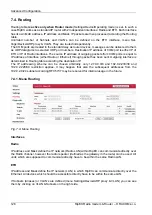
Flow control
List box: None, RTS/CTS
Default = None
RTS/CTS (Request To Send / Clear To Send) hardware flow control (handshake) between the DTE
(Data Terminal Equipment) and RipEX (DCE - Data Communications Equipment) can be enabled in
order to pause and resume the transmission of data. If RX buffer of RipEX is full, the CTS goes down.
Note:
RTS/CTS Flow control requires a 5-wire connection to the COM port.
Protocol*
List box: possible values
Default = None
Each SCADA protocol used on serial interface is more or less unique. The COM port daemon performs
conversion to standard UDP datagrams used in RipEX Radio network. Each protocol has its individual
configuration parameters, which are described in separate Help page (accessible from configuration
light box Protocol - click on Protocol, then on Help). Protocol “None” simply discards any data received
by the COM port or from the network, which means that the respective COM port is virtually disconnected
from the RipEX.
7.3.5. Protocols
Fig. 7.8: Menu Protocols COM
Generally
Each SCADA protocol like Modbus, DNP3, IEC101, DF1 etc. has its unique message format, most
importantly its unique way of addresing of remote units. The basic task for protocol utility is to check
whether received frame is within protocol format and it is not corrupted. Most of the SCADA protocols
are using some type of Error Detection Codes (Checksum, CRC, LRC, BCC, etc.) for data integrity
control, so RipEX calculates this code and check it with the received one.
RipEX radio network works in IP enviroment, so the basic task for Protocol interface utility is to convert
SCADA serial packets to UDP datagrams. The Address translation settings are used to define the
destination IP address and UDP port. Then these UDP datagrams are sent to RipEX router, processed
RipEX Radio modem & Router – © RACOM s.r.o.
114
Advanced Configuration
Summary of Contents for RipEX 1.6.0
Page 2: ......
















































